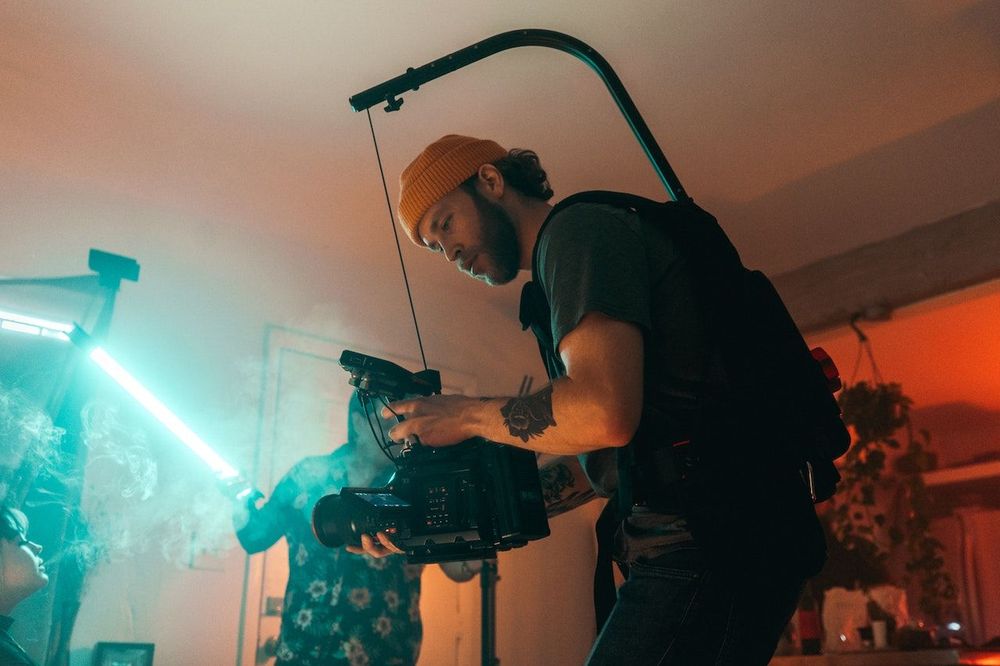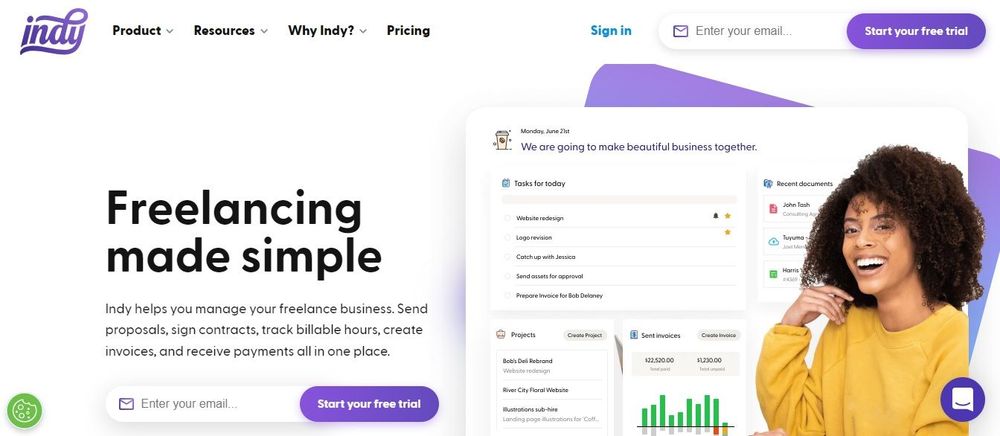When a client asks you to help them with a video production project, you need to make sure you can effectively communicate how you intend to do things and solve their specific needs. This is where a video production brief can make a huge difference. In this article, we will go through the main elements you should include in your video brief and show you some examples you can use to keep everyone informed and happy.
What is a video production brief, and why do you need one?
A video brief is a document that contains all the details necessary to make a video project a success. For example, your creative brief will typically include some background information about the client or the brand, specifications around the video's target audience, tone of voice, key messages that need to be included, timelines, budget, and how the video will be distributed.
The purpose of a video production brief is to provide all interested parties (for example, the video production agency and the client) with a clear understanding of what the production process will be like from start to finish. More importantly, it also contains all the information that can help keep things within an agreed timeline and budget. This makes the document a perfect tool to keep everyone on the same page.
Who creates the video production brief?
Although most video production creative freelancers and video agencies think it's their responsibility to create this document, it's always a good idea to involve all stakeholders in the process. This is because the creative brief will eventually become an excellent project management tool, so you'll be off to a great start if you can agree early on what to include in it. So, don't worry if you need to send your brief back and forth a couple of times; this is actually a great way to find common ground and polish your initial ideas.

Why do you need a video production creative brief?
The primary purpose of a video production brief is to help your video projects stay on track while also managing the expectations of everyone involved in the project. It's also a great way of preventing the scope from growing beyond what you expected and, in many cases, protecting you against unexpected client requirements. So, let's go through some of the main advantages of a good video production brief.
Managing expectations and tracking your video's progress
Perhaps one of the most challenging things when it comes to handling any video project is dealing with stakeholders' expectations. We know everyone involved in creating video content will want things to go well, but as a video producer, you might sometimes feel like you have to work a little hard to get people on the same page. You're not alone, and fortunately, others have already come up with effective ways of dealing with this situation.
By using a video production brief, you can make sure everyone's goals for the video can remain aligned. This is why it's crucial to start the video production journey by establishing a good relationship with your client. Make sure you ask all the questions that can help you work towards the same satisfactory outcome. For example, what are your client company's mission, vision, and values? What kind of deliverables will you be sharing, and within what timeline? And, of course, what is the allotted budget for the final video? (Don't worry, we will go through these questions in more detail when we work on the video production brief template).
Staying on track, staying on budget
In order to start on the right foot, it's always a great idea to have a discovery meeting or share an initial questionnaire with your client. The benefit of such an opportunity is that you can discover much more about the type of video content that is required. For example, is this an explainer video or a corporate video? Will it require post-production services? Is there a script already for the written video, or do you also need to create video content? And is there a marketing team that will take care of promoting and distributing the video on social media platforms?
These are just some questions you can ask in a discovery meeting, although chances are there will probably be many others depending on the video type, audience, marketing objectives, etc. Of course, budget is also a huge consideration and something you should always discuss beforehand, and so is the timeline. It's best to cross these hurdles early so you can create a common understanding of what's to come and create an effective plan of action for producing the video.
Managing scope creep
Scope creep is a term coined by software development teams, but one that project managers across all industries are now unfortunately familiar with. It refers to a situation where what the project has defined as "in scope" (included or expected) begins to unintentionally grow to include things you hadn't agreed on. In video production, scope creep can, for example, mean you're suddenly in charge not just of creating animations for a video but also of finding the music and doing the post-production.
Once this problem begins, it can be pretty difficult to stop it. And this applies to any step of the project; you might find yourself having to do countless revisions that push you to work harder to stay on schedule (and on budget!). A good video production brief should always be extremely clear about what's included in a project—and what's not. Or, to be a little more lenient, the costs of anything that is considered extra work!
The best way to prevent scope creep is to establish good communication and good planning from the get-go. Always include your deliverables and video production services. It's always better to be highly detailed in your creative brief than to suddenly spend hours doing something you weren't planning for.
How to create a video production brief (And things to avoid)
Before we look into the different parts of a video production brief in detail, let's quickly review some important steps for launching your project smoothly. These are absolutely not mandatory but can positively influence your video production process and lead to better collaboration down the road.

Knowing your client: Why do they want a video?
There are many types of clients, as you probably know if you've been in the industry for some time. We're used to reading about how to be great video producers, but there's no such guide as "how to be a good video producer's client"! So, it's always a good idea to be prepared for a few common scenarios you might encounter as part of your video-producing journey.
One of them is the infamous "know-it-all" client who wants to be actively involved with video production—but does not actually have any industry knowledge. Now, you should always listen to your client and accept their feedback, but remember they have come to you because you are the professional. Ensure you communicate this before it becomes an actual project dynamic. You might not believe it yet, but you can actually transform your "know-it-all" client into a "curious" one who is genuinely interested in the direction the video production is taking.
In any case, always get your client to express their ideas and goals for the video. Sometimes, they are the ones who know their audience best and can help you polish things to fit the brand and message better.
Setting realistic expectations
You should always be honest about the things you can (and cannot) do when producing a video. The industry is enormous, so you're not supposed to know everything. This is especially important as a freelancer, as you're often just a team of one.
For example, you can be an excellent video editor or animator but not be particularly comfortable with scripting or adding effects. Or you can excel at corporate videos but be a little rusty at explainer videos. The important thing to keep in mind is that you can always collaborate with others to achieve certain video goals, but you need to make this clear to your client. If in doubt, always underpromise in your video brief. Be transparent, and make sure you make promises only for the things you know you can deliver.
Keeping communication always open
It sounds evident, but having different ways for clients to contact you is a key step in any video production project. We really cannot emphasize the importance of communication more, especially if you're running your own business and want to make a great impression that can lead to your work being recommended. Your brand is so much more than the finished video; it's also how you treat clients and how open you are to their requests.
That's why it's essential to always include in your video brief different ways in which people can reach out to you. For example, mention your email (it's always a good idea to get requests in writing), but also a mobile phone in case of emergencies. You don't need to be available 24/7, but clients will genuinely appreciate having different means to contact you should they have a question.
What to include in a good video production brief (With template examples!)
We've gone through some considerations about starting things on the right foot with your client and keeping communication always open. Now, it's time to finally write that video production brief! Don't worry; it's not as hard as you might expect. We have divided our video production brief template into eight sections and added a few examples of things you can include to make it the best tool it can be. So, let's get started.
1. The business description
The first component of a video production brief is a description of the company or client asking for it. We recommend you include all the relevant business information here, for instance, the mission, vision, and goals. It's also a good idea to mention all the stakeholders that will be involved in the video creation, so anyone who needs help can know who to contact about the project, the budget, or the deliverables.
An easy way to include this information is by using a simple list (just fill it in with the details of your project):
"Company name: - Contact's Name: - Contact's Position: - Contact Information:"
"Company Values: - Company Mission: - Company Vision: - Additional Information:"
2. The video project overview and goals
The second component of your creative brief is the project scope and all the products you will deliver once it's finished. For example, you can start this section by describing whether the video will be a standalone piece or part of a larger campaign or initiative. Or the outcome you all expect from it. Try to avoid buzzwords like "to increase awareness" or "to inform" and instead focus on goals that can be measured. For example, are you aiming for a number of views on YouTube?
Your video project overview can include listed items as well. For example:
"Is this a standalone video or part of a campaign?: - Expected Deliverables: - Tone and Voice: - Target Audience: "
For the goals the video is expected to achieve, you can be more specific. For instance:
"We will create a one-minute original animated video promoting [Brand]'s new [Product]. The video will be uploaded to YouTube and promoted through social media on [Platforms]."

3. The target video audience
When creating a video (any kind of video), one of the most important considerations is who you are making it for. To think about the audience, it helps to consider the average age, gender, and media consumption habits of your watchers. Also, what jobs do they tend to have, and what types of content are they looking for?
It's not uncommon for clients to now know exactly who their prospective audience is. If they have done other videos and can show you some analytics, this can shed some light, but if they are attempting something new, you can actually help! What could set your video apart? Look at other similar media productions and find what things work and do not work. You can also offer to do some market research and create audience personas to understand the audience better.
When it's time to reflect your findings in the video production brief, you can do so in a list like this:
"Target Audience: - Age: - Gender: - Values: - Additional Information:"
"Competitors: Competitor 1: - Competitor 2: - Competitor 3:"
4. The video requirements, technical specifications, and distribution
Every video is unique, so naturally, they will each have their own specifications and requirements you need to keep in mind when presenting your production brief. You want to make sure you actually include as much information as you can about the video. For example, the format, the aspect ratio, and the video quality.
Another important consideration is the distribution model. Whenever possible, videos should be platform-specific, which means you should always try to have a distribution model in mind. The platform can help you understand the length the video needs to be, the aspect ratio it's best to use (for example, if it's a video for social media, square or vertical will do better than horizontal), whether there will be silent autoplay, and if you require to add also a Call to Action to visit a website or page.
Typically, a video production brief template will require you to write this section as a paragraph rather than a list. For example:
"We will create a 4:3 video of up to one minute. The video will rely on voice-over to maximize engagement, the reason why we will include captions at the bottom."
5. The timeline
The timeline is essential to any creative brief, no matter the industry. For video production, it can help everyone involved in a project understand. For example, you can state the timeline for when there will be a preview available, the window for requesting revisions, and the timeframe for launching the finalized version.
Having a timeline is helpful for all stakeholders, but it's especially useful for you as a video producer. In general, it will help you plan your resources better. It's essential, however, that you keep the timeline realistic. You don't want to find yourself having to work under pressure to deliver things on time. If in doubt, add a little extra time to your estimations.
A good way of presenting the timeline in your video production brief is by using milestones. For example:
"Video Project Timeline. Date/Milestone 1: - Date/Milestone 2: - Date/Milestone 3: - Date/Milestone 4: - Additional Information:"

6. The budget
Naturally, agreeing on the total budget for a project is paramount as well. The budget should include all expected expenses and can, in some cases, also mention other considerations for things that would fall outside the scope but are possible within the framework of the project. For example, you can have a project budget for a basic video and offer separate "add-ons" for music, voice-overs, animations, and other post-production services.
No matter what, make sure you always include a detailed breakdown of the budget. Having itemized items can help everyone understand the stage at which you are and create a shared vocabulary so you can discuss the project's progress more easily. An excellent way to write down your budget considerations in the video brief is by listing your requirements as a list. For example:
"Video Production Budget: Requirement 1: - Requirement 2: - Requirement 3: - Requirement 4: - Requirement 5: - Total Budget:"
7. The deliverables and approval process
After you are done with the project, your main deliverable should be one or more videos that are in an agreed state of completion (for instance, it can be just the visuals without post-production or a finished product). Make sure your design brief explains what the client is exactly getting. You can include the video format(s), supporting graphics, typefaces, mood boards, etc.
A critical component of your video brief is also an agreed approval process. Chances are, you're going to do frequent deliveries showing your progress. If your client is involved (as most are), they will want to see these materials and give you the thumbs up to continue with your production. Make sure you include this process in detail in your brief.
You can, again, use a simple list for your deliverables. For example:
"Video Project Deliverables: Deliverable 1: - Deliverable 2: - Deliverable 3: - Deliverable 4: - Additional Information:"
8. Stray observations
In some cases, your client can stipulate some special conditions for your video production process. In all of them, it's a good idea to include this in a last section called "stray observations."
Suppose, for example, that you are shooting a TV commercial... underwater. You want to ensure this condition will be mentioned in the video brief. Will you need special cameras? Or to travel to a location to do the shooting? Or perhaps there needs to be safety personnel around. Although the details are something better fitted for the contract, you will need to make sure anything that affects the video production process is mentioned here, too.
You can list these special observations as a list or a paragraph, depending on how many there are.
Create and manage your video production briefs with Indy
Indy makes managing video production tasks and administrative work extremely simple by offering a suite of powerful tools designed to help freelancers and video production agencies stay on top of their projects. With this platform, you can handle all project and client requirements from a single place and access calendars, chats, contracts, files, forms, invoices, proposals, tasks, and a powerful time tracker from the same dashboard.

If you need to create a video production brief, try Indy's Forms tool. Not only can you use our Basic Project Brief template (which contains all these sections and more), but you can also customize it to automatically add your client information and drag-and-drop any component you need to change the look and feel of your document. Indy's forms also allow you to personalize the video brief using your own branding, logo, and colors and share all documents with a super-easy link.
You don't need to spend time creating each video production brief from scratch. You can get started with Indy for free and start using up to two forms or design briefs immediately. But that's not all! You will also gain access to Indy's invoices, contracts, proposals, time tracker, calendars, and chats.



